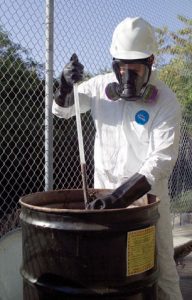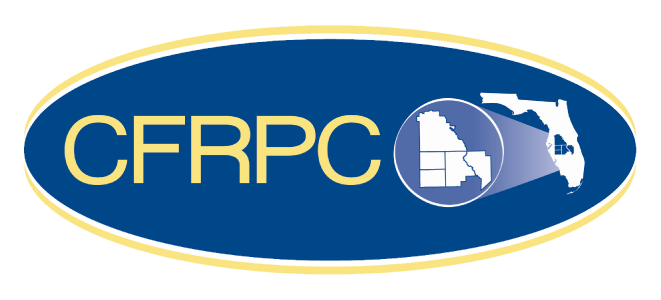Hazardous Materials Planning & Reporting
 The District VII Local Emergency Planning Committee (LEPC), staffed by the CFRPC, is charged with facilitating regional hazardous materials emergency response and compliance with hazardous materials reporting laws.
The District VII Local Emergency Planning Committee (LEPC), staffed by the CFRPC, is charged with facilitating regional hazardous materials emergency response and compliance with hazardous materials reporting laws.
Title III of the Superfund Amendments and Reauthorization Act (SARA), also known as the Emergency Planning and Community Right-to-Know Act of 1986 (EPCRA), requires public and private facilities that use, produce or store extremely hazardous substances or hazardous chemicals to report their inventories on an annual basis.
The CFRPC serves as the public access repository for the reports filed under EPCRA in the District VII LEPC area, which includes Polk, Hardee, Highlands, DeSoto, and Okeechobee Counties. This information is used to compile local and regional hazardous materials emergency response plans that are activated in the event of a chemical emergency. These plans are updated regularly as more facilities come into compliance or as inventories change.
As of June 1996 approximately 1,500 facilities in the District VII LEPC area had reported their chemical inventories. This number will continue to increase as awareness of the law reaches various segments of the community. As the database increases, the information it contains will be invaluable to local planning and zoning boards as the area continues to grow. The information also greatly enhances safety for local fire departments, hazardous materials teams and other emergency responders.
CFRPC is providing emergency response training to first responders through a Hazardous Materials Emergency Preparedness (HMEP) grant. This training is provided through the acquisition of training materials and the location of qualified instructors to provide the training to fire, law enforcement and emergency medical personnel. Also through the HMEP grant, CFRPC, in conjunction with the District VII LEPC, is performing community workshops to raise public awareness with regards to hazardous materials.
CFRPC also produces hazardous materials emergency response plans for local governments on a contractual basis. In so doing, the Council provides the expertise in completing the hazards analysis that is required for the hazardous materials emergency response plans. Council staff also provides technical assistance to the counties in the performing of hazards analysis and the running of computer program which assist in the hazards analysis process.
Central Florida Local Emergency Planning Committee (LEPC)
The CFRPC is the coordinator for the Local Emergency Planning Committee (LEPC) that is responsible for increasing hazardous materials safety and awareness. Read more…
LEPC Meeting Information
Hazardous Analysis Inspections
 The Hazards Analysis (HA) program monitors facilities that have extremely hazardous substances held in stock or used in their day to day operations. Some of these chemicals include Anhydrous Ammonia, Paraquat Dichloride, Sulfuric Acid and Chlorine. CFRPC conducts inspections in Okeechobee, Hardee and DeSoto Counties under the HA inspection program. Each year the Council assesses approximately 15 sites as directed by the State of Florida. The data collected is used by the LEPC and local first responders to develop hazardous materials emergency plans for use in responding to and recovering from a release or spill of hazardous or toxic substances.
The Hazards Analysis (HA) program monitors facilities that have extremely hazardous substances held in stock or used in their day to day operations. Some of these chemicals include Anhydrous Ammonia, Paraquat Dichloride, Sulfuric Acid and Chlorine. CFRPC conducts inspections in Okeechobee, Hardee and DeSoto Counties under the HA inspection program. Each year the Council assesses approximately 15 sites as directed by the State of Florida. The data collected is used by the LEPC and local first responders to develop hazardous materials emergency plans for use in responding to and recovering from a release or spill of hazardous or toxic substances.
Small Quantity Generators of Hazardous Waste
The Small Quantity Generators (SQG) program identifies and monitors facilities that produce some form of hazardous waste either as a product or a by-product of their day to day business. This includes, but is not limited to, automotive repair facilities, dry cleaners, medical facilities that use x-ray machines, and many manufacturing businesses. The CFRPC conducted 285 inspections in three counties in 2010. All facilities are inspected every five years. The CFRPC maintains records of active businesses and historical data concerning the type of businesses that have occupied a given address in the past.
Shelter In Place
Hazardous materials are common in our environment because they are used by industry, business, government and private citizens on a daily basis. If a material has a potential to damage human life it is considered hazardous.
The key to safety is knowing what to do and what not to do if a hazardous material spill or accident occurs.
Protect Your Breathing:
- Cover your nose and mouth with a damp handkerchief or, if possible, a large wet bath towel or cloth
Shelter-In-Place:
- Could last a maximum of 2-3 hours
- Go inside and bring pets inside. (Stay there until your local radio or TV stations report that you may leave)
- Close and lock all doors and windows (Use masking tape or damp towels to seal the openings if possible)
- If an explosion is possible outdoors — close drapes, curtains, and shades over windows. Stay away from external windows to prevent potential injury from flying glass.
- Close window curtains, shades and blinds (to keep house cool)
- Turn OFF heating, cooling and ventilation systems (to prevent outside air from entering)
- Turn off all exhaust fans in kitchens, bathrooms, and other spaces.
- Do not use fireplaces. (Put out the fire, close the dampers)
- Do NOT go to school to pick up your children. (School officials will be prepared to take special precautions)
- Go to an above ground room with the fewest windows and doors. (If possible, choose one with an adjoining bathroom)
- Jam wet towels in the cracks under doors and windows to block air flow.
- Block air vents using plastic sheeting or bags and tape.
- If there is no building to shelter in place get into a car.
- Listen to your radio or television for further instructions.
- Limit phone calls, since lines may be needed for emergency response.
Shelter-In-Place Kit:
- Shelter in Place Instructions
- 1 gallon of Bottled Water
- Plastic Drop Cloth (to seal vents and windows)
- Duct Tape (for sealing cracks)
- Moist Towels (to seal off shelter door)
- AM/FM radio with batteries
- Know what hazardous substances are produced, stored or transported in your area.
- Learn location of ventilation system shut off for your home/location.
- Determine your shelter-in-place location and repair seals around windows and doors.
